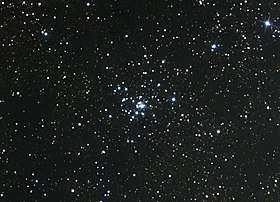M21 | NGC 6531 | Webb’s Cross | Sagittarius | 4,300 Light Years Away
Messier 21 is an open star cluster located in the constellation Sagittarius, discovered by Charles Messier in 1764. Positioned approximately 4,250 light-years away from Earth, this cluster is relatively young, with an estimated age of around 4.6 million years. The stars within Messier 21 are gravitationally bound and share a common origin from the same molecular cloud of gas and dust, making them part of a stellar family.
Composed of around 57 stars, Messier 21 spans about 13 light-years in diameter and is characterized by its dense central core and the scattering of stars towards its outer regions. The cluster is part of the rich star fields of the Milky Way’s galactic center, adding to the visual splendor of the region. Observations of Messier 21 contribute to the study of open star clusters, helping astronomers understand the dynamics of stellar systems and the processes involved in the formation and evolution of stars within our galaxy.
While not as prominent as some other celestial objects, Messier 21 remains an intriguing target for astronomers and astrophotographers due to its association with the broader Sagittarius Star Cloud. The study of open clusters like Messier 21 contributes valuable information about the composition, age, and distribution of stars in the Milky Way, enhancing our understanding of the diverse stellar populations that populate our galaxy’s spiral arms. Messier 21 serves as a testament to the ongoing processes of star birth and evolution within the intricate tapestry of the cosmos.

